
Vienna is the capital, largest city, and one of nine states of Austria. Vienna is Austria's most populous city and its primate city, with about two million inhabitants, and its cultural, economic, and political center. It is the 6th-largest city proper by population in the European Union and the largest of all cities on the Danube river.

The Eurovision Song Contest 1967 was the 12th edition of the annual Eurovision Song Contest. It took place in Vienna, Austria, following the country's victory at the 1966 contest with the song "Merci, Chérie" by Udo Jürgens. Organised by the European Broadcasting Union (EBU) and host broadcaster Österreichischer Rundfunk (ORF), the contest was held at the Großer Festsaal der Wiener Hofburg on 8 April 1967, becoming the first contest held in the month of April, and was hosted by Austrian actress Erica Vaal.

Brixen is a town in South Tyrol, northern Italy, located about 40 kilometres (25 mi) north of Bolzano.

The Kunsthistorisches Museum is an art museum in Vienna, Austria. Housed in its festive palatial building on the Vienna Ring Road, it is crowned with an octagonal dome. The term Kunsthistorisches Museum applies to both the institution and the main building. It is the largest art museum in the country and one of the most important museums worldwide.

The Burgtheater, originally known as K.K. Theater an der Burg, then until 1918 as the K.K. Hofburgtheater, is the national theater of Austria in Vienna. It is the most important German-language theater and one of the most important theatres in the world. The Burgtheater was opened in 1741 and has become known as "die Burg" by the Viennese population; its theater company has created a traditional style and speech typical of Burgtheater performances.

The Vienna Ring Road is a 5.3 km circular grand boulevard that serves as a ring road around the historic Innere Stadt district of Vienna, Austria. The road is located on sites where medieval city fortifications once stood, including high walls and the broad open field ramparts (glacis), criss-crossed by paths that lay before them.
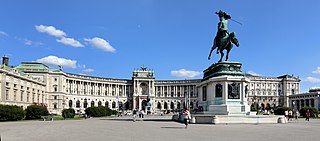
The Hofburg is the former principal imperial palace of the Habsburg dynasty. Located in the centre of Vienna, it was built in the 13th century and expanded several times afterwards. It also served as the imperial winter residence, as Schönbrunn Palace was the summer residence. Since 1946, it is the official residence and workplace of the president of Austria.
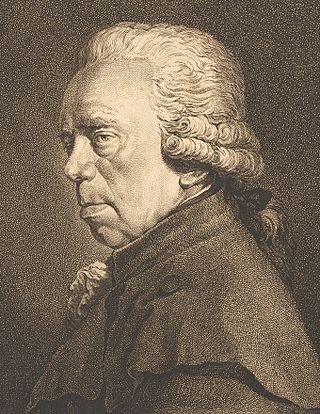
Johann Christian Brand was an Austrian painter and brother of Friedrich August Brand. Johann Christian Brand influenced ending the baroque era of landscape painting. He died in Vienna.

Michael Arthur Josef Jakob Hainisch was an Austrian politician who served as the first President of Austria from 1920 to 1928, after the fall of the monarchy at the end of World War I.

The Austrian National Library is the largest library in Austria, with more than 12 million items in its various collections. The library is located in the Neue Burg Wing of the Hofburg in center of Vienna. Since 2005, some of the collections have been relocated within the Baroque structure of the Palais Mollard-Clary. Founded by the Habsburgs, the library was originally called the Imperial Court Library ; the change to the current name occurred in 1920, following the end of the Habsburg Monarchy and the proclamation of the Austrian Republic. The library complex includes four museums, as well as multiple special collections and archives.
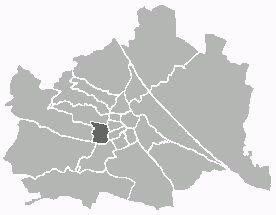
Rudolfsheim-Fünfhaus is the 15th municipal District of Vienna, Austria. It is in central Vienna, west of Innere Stadt.

Johann Lukas von Hildebrandt was an Austrian baroque architect and military engineer who designed stately buildings and churches and whose work had a profound influence on the architecture of the Habsburg Empire in the eighteenth century. After studying in Rome under Carlo Fontana, he constructed fortresses for Prince Eugene of Savoy during his Italian campaigns, becoming his favorite architect. In 1700 he became court engineer in Vienna, and in 1711 was named head of the court department of building. He became court architect in 1723. His designs for palaces, estates, gardens, churches, chapels, and villas were widely imitated, and his architectural principles spread throughout central and southeast Europe. Among his more important works are Palais Schwarzenberg, St. Peter's Church, and Belvedere in Vienna, Savoy Castle in Ráckeve, Schönborn Palace in Göllersdorf, and Schloss Hof.

St. Rupert's Church is a Romanesque church in Vienna, Austria. Traditionally considered to be the oldest church in the city, St. Rupert's Church is dedicated to Saint Rupert of Salzburg, patron saint of the salt merchants of Vienna. The church is located in one of the oldest parts of the city, the section of the Roman Vindobona.
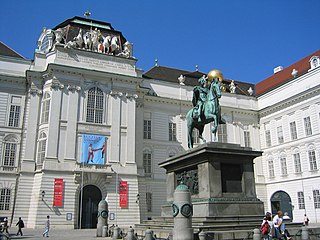
Josefsplatz is a public square located at the Hofburg Palace in Vienna, Austria. Named after Emperor Joseph II, Josefsplatz is considered one of the finest courtyards in Vienna.

Ballhausplatz is a square in central Vienna containing the building that for over two hundred years has been the official residence of the most senior Austrian Cabinet Minister, the State Chancellor, today the Chancellor of Austria. As a result, Ballhausplatz is often used as shorthand for the Austrian Federal Chancellery. Until 1918 the Foreign Ministry of Austria-Hungary was also housed here. Similar to Downing Street or the Hotel Matignon, the word Ballhausplatz is a synecdoche for the seat of power.

The Galli–Bibiena family, or Galli da Bibiena, was a family of Italian artists of the 17th and 18th centuries, including:

Francesco Galli, called Francesco da Bibiena, a member of the theatrical Galli da Bibiena family and younger brother of Ferdinando Galli, was born at Bologna in 1659. He first studied under Lorenzo Pasinelli; but he was afterwards instructed in the school of Carlo Cignani. His knowledge of architecture and perspective was considerable; but he excelled in figures. Francesco worked at Piacenza, Parma, and Rome, and then became ducal architect at Mantua. After a stay in Genoa and Naples he was called to Vienna, where he built a large theatre. He worked successively for the Emperors Leopold I and Joseph I, and was invited to Madrid by Philip V, who appointed him his principal architect. He died in 1739.

Tulln an der Donau is a historic town in the Austrian state of Lower Austria, the administrative seat of Tulln District. Because of its abundance of parks and gardens, Tulln is often referred to as Blumenstadt, and "The City of Togetherness" following the initiative of Peter Eisenschenk, Mayor of Tulln.
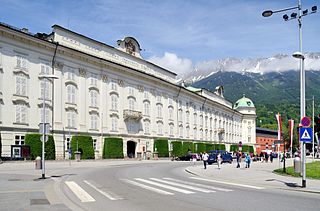
The Hofburg is a former Habsburg palace in Innsbruck, Austria, and considered one of the three most significant cultural buildings in the country, along with the Hofburg Palace and Schönbrunn Palace in Vienna. The Hofburg is the main building of a large residential complex once used by the Habsburgs that still includes the Noblewomen's Collegiate Foundation, the Silver Chapel, the Hofkirche containing Emperor Maximilian's cenotaph and the Schwarzen Mandern, the Theological University, the Tyrolean Folk Art Museum, Innsbruck Cathedral, the Congress, and the Hofgarten.

The Papyrus Collection of the Austrian National Library, also known as the Rainer Collection and Vienna Papyrus Collection, is a papyrus collection of the Austrian National Library at Hofburg palace in Vienna. It contains around 180,000 objects overall. It is one of the most significant collections in papyrology, containing writings documenting 3 millennia of the history of Egypt from 1500 BCE–1500 CE: Ancient Egypt, Hellenistic Egypt, Roman Egypt, and Egypt during Muslim rule. It includes a specialist library of around 19,500 books and journals as well. The Austrian National Library preserves and restores the stored papyri and facilitates scholarly research and publication based on these ancient documents.




















